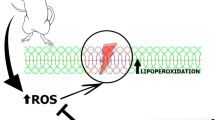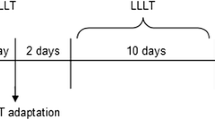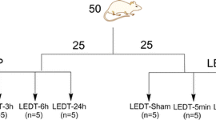Abstract
High-intensity resistance exercise (RE) increases oxidative stress leading to deleterious effects on muscle performance and recovery. The aim of this study was to assess the effect of applying low-level laser therapy (LLLT) prior to a RE session on muscle oxidative stress and to determine the possible influence of the dosimetric parameters. Female Wistar rats were assigned to non-LLLT (Ctr: non-exercised control; RNI: RE) or LLLT groups subjected to RE (radiant energy: 4 J, 8 J, and 12 J, respectively). RE consisted of four maximum load climbs. An 830-nm DMC Lase Photon III was used to irradiate three points in gastrocnemius muscles (two limbs) before exercise. Animals were euthanized after 60 min after the end of the exercise, and muscle tissue was removed for analysis of oxidative stress markers. All doses resulted in the prevention of increased lipoperoxidation; however, LLLT prevented protein oxidation only in rats that were pretreated with 8 J and 12 J of energy by LLLT. RE and LLLT did not change catalase activity. However, RE resulted in lower superoxide dismutase activity, and the opposite was observed in the LLLT group. These data indicate that LLLT prior to RE can prevent muscle oxidative stress. This study is the first to evaluate the impact of dosimetric LLLT parameters on the oxidative stress induced by RE, wherein both 8 J and 12 J of energy afforded significant protection.




Similar content being viewed by others
References
Retamoso LT, Silveira MEJ, Lima FD, Busanello GL, Bresciani G, Ribeiro LR, Chagas PM, Nogueira CW, Braga AC, Furian AF, Oliveira MS, Fighera MR, Royes LF (2016) Increased xanthine oxidase-related ROS production and TRPV1 synthesis preceding DOMS post-eccentric exercise in rats. Life Sci 152:52–59. https://doi.org/10.1016/j.lfs.2016.03.029
Wiecek M, Maciejczyk M, Szymura J, Szygula Z (2017) Effect of maximal-intensity exercise on systemic nitro-oxidative stress in men and women. Redox Rep 22(4):176–182. https://doi.org/10.1080/13510002.2016.1169622
Sunemi SM, Silva FA, Antonio EL, Tucci PJF, Serra AJ (2019) Photobiomodulation: newly discovered actions in resistance exercise. Reactive oxygen species 7(21):148–153. https://doi.org/10.20455/ros.2019.829
De Marchi T, Leal Junior EC, Bortoli C, Tomazoni SS, Lopes-Martins RA, Salvador M (2012) Low-level laser therapy (LLLT) in human progressive-intensity running: effects on exercise performance, skeletal muscle status, and oxidative stress. Lasers Med Sci 27(1):231–236. https://doi.org/10.1007/s10103-011-0955-5
De Marchi T, Leal-Junior ECP, Lando KC, Cimadon F, Vanin AA, da Rosa DP, Salvador M (2019) Photobiomodulation therapy before futsal matches improves the staying time of athletes in the court and accelerates post-exercise recovery. Lasers Med Sci 34(1):139–148. https://doi.org/10.1007/s10103-018-2643-1
de Oliveira HA, Antonio EL, Arsa G, Santana ET, Silva FA, Junior DA, Dos Santos S, de Carvalho PTC, Leal-Junior ECP, Araujo A, De Angelis K, Bocalini DS, Junior JAS, Tucci PJF, Serra AJ (2018) Photobiomodulation leads to reduced oxidative stress in rats submitted to high-intensity resistive exercise. Oxidative Med Cell Longev 2018:5763256. https://doi.org/10.1155/2018/5763256
Huang YY, Sharma SK, Carroll J, Hamblin MR (2011) Biphasic dose response in low level light therapy - an update. Dose-Response 9(4):602–618. https://doi.org/10.2203/dose-response.11-009.Hamblin
de Oliveira HA, Antonio EL, Silva FA, de Carvalho PTC, Feliciano R, Yoshizaki A, Vieira SS, de Melo BL, Leal-Junior ECP, Labat R, Bocalini DS, Silva Junior JA, Tucci PJF, Serra AJ (2018) Protective effects of photobiomodulation against resistance exercise-induced muscle damage and inflammation in rats. J Sports Sci 36(20):2349–2357. https://doi.org/10.1080/02640414.2018.1457419
Antonialli FC, De Marchi T, Tomazoni SS, Vanin AA, dos Santos GV, de Paiva PR, Pinto HD, Miranda EF, de Tarso Camillo de Carvalho P, Leal-Junior EC (2014) Phototherapy in skeletal muscle performance and recovery after exercise: effect of combination of super-pulsed laser and light-emitting diodes. Lasers Med Sci 29(6):1967–1976. https://doi.org/10.1007/s10103-014-1611-7
de Oliveira AR, Vanin AA, Tomazoni SS, Miranda EF, Albuquerque-Pontes GM, De Marchi T, Dos Santos GV, de Paiva PRV, Imperatori TBG, de Carvalho PTC, Bjordal JM, Leal-Junior ECP (2017) Pre-exercise infrared Photobiomodulation therapy (810 nm) in skeletal muscle performance and postexercise recovery in humans: what is the optimal power output? Photomed Laser Surg 35(11):595–603. https://doi.org/10.1089/pho.2017.4343
Grandinetti V, Carlos FP, Antonio EL, de Oliveira HA, Dos Santos LFN, Yoshizaki A, Mansano B, Silva FA, Porte LA, Albuquerque-Pontes GM, de Carvalho PTC, Manchini MT, Leal-Junior EC, Tucci PJF, Serra AJ (2019) Photobiomodulation therapy combined with carvedilol attenuates post-infarction heart failure by suppressing excessive inflammation and oxidative stress in rats. Sci Rep 9(1):9425. https://doi.org/10.1038/s41598-019-46021-1
Cohen J (1992) A power primer. Psychol Bull 112(1):155–159
Amadio EM, Serra AJ, Guaraldo SA, Silva JA Jr, Antonio EL, Silva F, Portes LA, Tucci PJ, Leal-Junior EC, de Carvalho PT (2015) The action of pre-exercise low-level laser therapy (LLLT) on the expression of IL-6 and TNF-alpha proteins and on the functional fitness of elderly rats subjected to aerobic training. Lasers Med Sci 30(3):1127–1134. https://doi.org/10.1007/s10103-015-1713-x
De Marchi T, Schmitt VM, Machado GP, de Sene JS, de Col CD, Tairova O, Salvador M, Leal-Junior EC (2017) Does photobiomodulation therapy is better than cryotherapy in muscle recovery after a high-intensity exercise? A randomized, double-blind, placebo-controlled clinical trial. Lasers Med Sci 32(2):429–437. https://doi.org/10.1007/s10103-016-2139-9
Nampo FK, Cavalheri V, Dos Santos SF, de Paula RS, Camargo EA (2016) Low-level phototherapy to improve exercise capacity and muscle performance: a systematic review and meta-analysis. Lasers Med Sci 31(9):1957–1970. https://doi.org/10.1007/s10103-016-1977-9
Baroni BM, Leal Junior EC, De Marchi T, Lopes AL, Salvador M, Vaz MA (2010) Low level laser therapy before eccentric exercise reduces muscle damage markers in humans. Eur J Appl Physiol 110(4):789–796. https://doi.org/10.1007/s00421-010-1562-z
Ferraresi C, de Sousa MV, Huang YY, Bagnato VS, Parizotto NA, Hamblin MR (2015) Time response of increases in ATP and muscle resistance to fatigue after low-level laser (light) therapy (LLLT) in mice. Lasers Med Sci 30(4):1259–1267. https://doi.org/10.1007/s10103-015-1723-8
d'Ischia M, Palumbo A, Buzzo F (2000) Interactions of nitric oxide with lipid peroxidation products under aerobic conditions: inhibitory effects on the formation of malondialdehyde and related thiobarbituric acid-reactive substances. Nitric Oxide 4(1):4–14. https://doi.org/10.1006/niox.1999.0268
Moselhy HF, Reid RG, Yousef S, Boyle SP (2013) A specific, accurate, and sensitive measure of total plasma malondialdehyde by HPLC. J Lipid Res 54(3):852–858. https://doi.org/10.1194/jlr.D032698
Antolovich M, Prenzler PD, Patsalides E, McDonald S, Robards K (2002) Methods for testing antioxidant activity. Analyst 127(1):183–198
Dunlop RA, Brunk UT, Rodgers KJ (2009) Oxidized proteins: mechanisms of removal and consequences of accumulation. IUBMB Life 61(5):522–527. https://doi.org/10.1002/iub.189
Radak Z, Zhao Z, Koltai E, Ohno H, Atalay M (2013) Oxygen consumption and usage during physical exercise: the balance between oxidative stress and ROS-dependent adaptive signaling. Antioxid Redox Signal 18(10):1208–1246. https://doi.org/10.1089/ars.2011.4498
Kozakowska M, Pietraszek-Gremplewicz K, Jozkowicz A, Dulak J (2015) The role of oxidative stress in skeletal muscle injury and regeneration: focus on antioxidant enzymes. J Muscle Res Cell Motil 36(6):377–393. https://doi.org/10.1007/s10974-015-9438-9
Morrison D, Hughes J, Della Gatta PA, Mason S, Lamon S, Russell AP, Wadley GD (2015) Vitamin C and E supplementation prevents some of the cellular adaptations to endurance-training in humans. Free Radic Biol Med 89:852–862. https://doi.org/10.1016/j.freeradbiomed.2015.10.412
Acknowledgments
The authors are grateful to Editage for English language editing.
Funding
This work was supported by the São Paulo Research Foundation (FAPESP) [grant 2018/06865–7] and Brazilian National Council for Scientific and Technological Development (CNPq) [grant 305,527/2017–7]. Funding sources were not involved in the study design, collection, analysis, or interpretation of data. The content is solely the responsibility of the authors and does not necessarily represent the official views of the funding sources.
Author information
Authors and Affiliations
Corresponding author
Ethics declarations
Conflict of interest
The authors declare that they have no conflict of interest.
Ethical approval
The study was approved by the Institutional Research Ethics Committee of the Federal University of São Paulo, São Paulo – SP, Brazil (process no 8868250615).
Additional information
Publisher’s note
Springer Nature remains neutral with regard to jurisdictional claims in published maps and institutional affiliations.
Rights and permissions
About this article
Cite this article
dos Santos, S.S., de Oliveira, H.A., Antonio, E.L. et al. Low-level laser therapy prevents muscle oxidative stress in rats subjected to high-intensity resistance exercise in a dose-dependent manner. Lasers Med Sci 35, 1689–1694 (2020). https://doi.org/10.1007/s10103-020-02951-1
Received:
Accepted:
Published:
Issue Date:
DOI: https://doi.org/10.1007/s10103-020-02951-1




